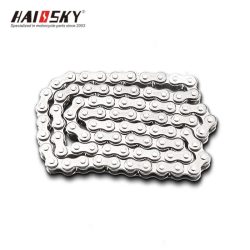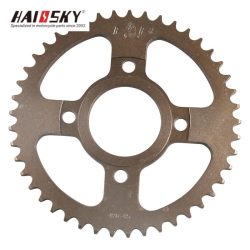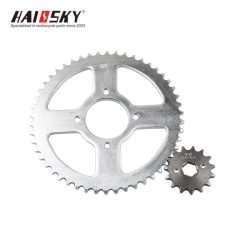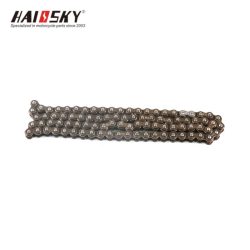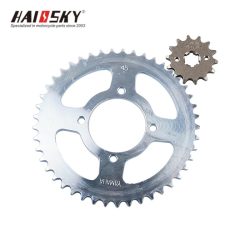OEM Motorcycle Parts
Category: Motorcycle Sprocket & Chain Kits - X-Ring Sets
Motorcycle Sprocket & Chain: A Comprehensive Guide for B2B Buyers
Motorcycle sprockets and chains are critical components of a bike’s drivetrain, responsible for transferring power from the engine to the rear wheel. For B2B buyers in the motorcycle parts industry, understanding the types, maintenance, and selection criteria for sprockets and chains is essential for meeting customer needs. In this guide, we’ll explore everything you need to know about motorcycle sprocket and chain kits, optimized for the keyword, while answering key questions to help you make informed decisions.
Does a Bigger Sprocket Make It Go Faster or Slower?
The size of the sprocket directly affects a motorcycle’s speed and acceleration. Here’s how it works:
Larger Rear Sprocket: A bigger rear sprocket increases torque and acceleration but reduces top speed. This setup is ideal for off-road riding or track days where quick bursts of speed are needed.
Smaller Rear Sprocket: A smaller rear sprocket increases top speed but reduces acceleration. This is suitable for highway cruising or long-distance touring.
Front Sprocket Changes: Increasing the size of the front sprocket has the opposite effect of increasing the rear sprocket. A larger front sprocket increases top speed but reduces acceleration, while a smaller front sprocket improves acceleration at the cost of top speed.
In summary, sprocket size is a trade-off between speed and acceleration, and the ideal setup depends on the rider’s preferences and riding conditions.
How Do You Match a Chain and Sprocket?
Matching a chain and sprocket is crucial for optimal performance and longevity. Here’s how to ensure compatibility:
Pitch: The pitch is the distance between the chain’s rollers. Common pitches for motorcycles are 520, 525, and 530. The chain and sprockets must have the same pitch.
Width: The chain’s width must match the sprocket’s thickness. For example, a 520 chain is narrower than a 530 chain.
Tooth Count: The number of teeth on the sprockets affects the bike’s gearing. Ensure the chain length matches the sprocket combination.
Material: Use chains and sprockets made from compatible materials. For example, steel chains pair well with steel or aluminum sprockets.
Brand and Quality: Stick to reputable brands like DID, RK, or Regina to ensure compatibility and durability.
What Size Sprocket Is Best for Speed?
The best sprocket size for speed depends on the motorcycle’s intended use:
Highway Riding: A smaller rear sprocket (e.g., 40-45 teeth) or a larger front sprocket (e.g., 16-18 teeth) increases top speed and fuel efficiency.
Off-Road or Racing: A larger rear sprocket (e.g., 48-52 teeth) or a smaller front sprocket (e.g., 13-15 teeth) improves acceleration and low-end torque.
Balanced Setup: For general-purpose riding, a stock or slightly modified sprocket setup provides a good balance between speed and acceleration.
Always consider the motorcycle’s engine power, weight, and riding conditions when selecting sprocket sizes.
How Long Does a Motorcycle Chain and Sprocket Last?
The lifespan of a motorcycle chain and sprocket depends on several factors:
Maintenance: Regular cleaning, lubrication, and tension adjustment can extend the lifespan to 20,000-30,000 miles.
Riding Conditions: Off-road or wet conditions can accelerate wear, reducing lifespan to 10,000-15,000 miles.
Quality: High-quality chains and sprockets made from materials like O-ring or X-ring chains and hardened steel sprockets last longer.
Usage: Aggressive riding or high torque loads can shorten the lifespan.
Signs of wear include chain elongation, sprocket tooth deformation, and excessive noise. Regular inspection and timely replacement are key to preventing drivetrain damage.
Types of Motorcycle Sprocket and Chain Kits
Motorcycle sprocket and chain kits come in various types to suit different riding styles and conditions. Here’s an overview:
- Standard Kits
Material: Steel sprockets and chains.
Use: Ideal for everyday riding on paved roads.
Pros: Durable and cost-effective.
Cons: Not suitable for extreme conditions.
- Heavy-Duty Kits
Material: High-strength steel or alloy sprockets and chains.
Use: Designed for high-performance or off-road motorcycles.
Pros: Handles more power and torque.
Cons: Heavier and more expensive.
- Custom Kits
Material: Tailored to specific motorcycle models.
Use: Perfect fit and improved performance.
Pros: Enhances drivetrain reliability.
Cons: Higher cost and limited availability.
- High-Strength Steel Chains
Material: Chromium-molybdenum or carbon steel.
Use: Racing or heavy-duty applications.
Pros: Excellent wear resistance and load capacity.
Cons: Requires regular maintenance.
- Aluminum Alloy Sprockets
Material: Lightweight aluminum.
Use: Racing or high-speed riding.
Pros: Reduces weight for better acceleration.
Cons: Less durable than steel.
Specifications and Maintenance of Motorcycle Sprocket and Chain Kits
Key Specifications:
Material: High-strength steel, aluminum alloy, or stainless steel.
Size: Chain pitch (520, 525, 530) and sprocket tooth count.
Type: Countershaft (front), rear, or idler sprockets.
Brand: Reputable brands like DID, RK, and Regina ensure quality and performance.
Maintenance Tips:
Check Chain Tension: Maintain 20-30 mm of vertical movement for optimal tension.
Clean the Chain: Use a chain cleaner or kerosene to remove dirt and grime.
Lubricate Regularly: Apply high-quality chain lubricant to reduce friction.
Inspect for Wear: Replace worn chains or sprockets to prevent drivetrain damage.
Adjust Alignment: Ensure the chain runs straight between the sprockets.
How to Choose Motorcycle Sprocket and Chain Kits
When sourcing sprocket and chain kits for your business, consider the following factors:
Riding Style: Choose kits based on the intended use (e.g., racing, touring, or off-road).
Material: Opt for durable materials like high-strength steel or lightweight aluminum.
Size and Compatibility: Ensure the chain pitch and sprocket tooth count match the motorcycle’s specifications.
Brand and Quality: Stick to reputable brands for reliability and performance.
Budget: Balance cost with quality to meet customer expectations.
How to DIY and Replace Motorcycle Sprocket and Chain Kits
Replacing a sprocket and chain kit is a manageable DIY task. Here’s a step-by-step guide:
Tools Needed:
Socket wrench.
Torque wrench.
Chain rivet tool.
Screwdriver.
Paddock stand.
Steps:
Prepare the Motorcycle: Secure the bike on a paddock stand and clean the drivetrain area.
Remove the Old Chain and Sprockets:
Loosen the rear axle nut and chain tension adjusters.
Remove the master link and take off the old chain.
Unscrew the bolts holding the sprockets and remove them.
Install the New Sprockets:
Attach the new front sprocket and tighten the bolts to the manufacturer’s torque specifications.
Install the new rear sprocket and align it with the front sprocket.
Install the New Chain:
Thread the new chain through the sprockets and break it to the correct length.
Install a new master link and secure it using a chain rivet tool.
Adjust Chain Tension: Set the chain tension to 20-30 mm and ensure proper alignment.
Final Checks: Spin the rear wheel to verify smooth operation and test ride the motorcycle.
Q&A
Q1: Does a bigger sprocket make it go faster or slower?
A1: A bigger rear sprocket increases acceleration but reduces top speed, while a smaller rear sprocket increases top speed but reduces acceleration.
Q2: How do you match a chain and sprocket?
A2: Ensure the chain pitch, width, and tooth count match the sprockets. Use compatible materials and reputable brands.
Q3: What size sprocket is best for speed?
A3: A smaller rear sprocket or larger front sprocket increases top speed, making it ideal for highway riding.
Q4: How long does a motorcycle chain and sprocket last?
A4: With proper maintenance, a chain and sprocket can last 20,000-30,000 miles, but harsh conditions or aggressive riding can reduce lifespan.


